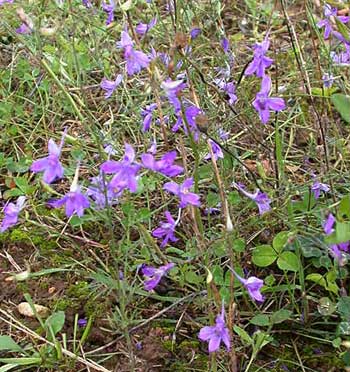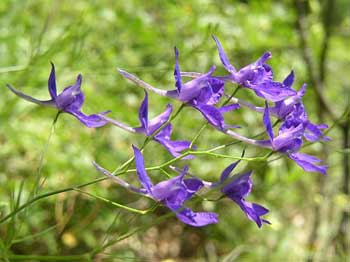Contents:
Common Names | Parts Usually Used | Plant(s) & Culture | Where Found | Medicinal Properties | Biochemical Information
Uses | Formulas or Dosages | Warning | Bibliography
Scientific Names

- Delphinium consolida L.
- Consolida regalis L.
- Ranunculaceae
- Buttercup family
Common Names
- Branching larkspur
- Delphinium
- Knight’s spur
- Lark’s heel
- Lark’s claw
- Staggerweed
- Stavesacre
Parts Usually Used
Flowering plant, root, seeds
Back to Top

Description of Plant(s) and Culture
Larkspur is an annual plant; it has a slender taproot that produces the leafy, branching stem growing to a height of 2-4 feet and bears both petioled and sessile, finely divided leaves. The blue or purple flowers feature a spur projecting backward from the upper part and grow in terminal racemes from June to August.
Another variety: Red larkspur (D. nudicaule), also known as sleep root. Root has narcotic properties, which are made use of in causing an opponent to become stupid in gambling. Tea from root.
Back to Top
Where Found
Grows in rich or dry woods and on rocky slopes throughout the United States but most commonly in the western states; it is also common in Europe.
Back to Top
Medicinal Properties
Anthelmintic, cathartic, emetic, narcotic, parasitcide, purgative
Back to Top
Biochemical Information
A poisonous alkaloid, calcatrippine, which is the same as aconitine
Back to Top
Uses
Larkspur has a relatively weak action, is not much used medicinally today.
Poisoning is possible if large quantities are consumed; seeds and the young plants are dangerous.
Larkspur is made into a lotion or tincture for topical application to kill lice, crabs, and other parasites. Do not use internally
Back to Top
Formulas or Dosages
Gather the flowering plant before seed formation.
Infusion: steep 1 tsp. dried plant in 1 cup water for 5 minutes. Take 1 cup per day. Do not use internally.
Back to Top
Warning
Several species are poisonous. Poisoning is possible if large quantities are consumed; seeds and the young plants are dangerous. Do not use internally.
Back to Top
Bibliography
![]() The Herb Book
The Herb Book, by John Lust, Bantam Books, 666 Fifth Avenue, New York, NY. copyright 1974.
![]() Indian Herbalogy of North America
Indian Herbalogy of North America, by Alma R. Hutchens, Shambala Publications, Inc., Horticultural Hall, 300 Massachusetts Avenue, Boston, Massachusetts 02115, 1973
![]() Indian Uses of Native Plants
Indian Uses of Native Plants, by Edith Van Allen Murphey, Meyerbooks, publisher, PO Box 427, Glenwood, Illinois 60425, copyright 1958, print 1990
![]() Planetary Herbology
Planetary Herbology, by Michael Tierra, C.A., N.D., O.M.D., Lotus Press, PO Box 325, Twin Lakes. WI 53181., Copyright 1988, published 1992
![]() Webster’s New World Dictionary
Webster’s New World Dictionary, Third College Edition, Victoria Neufeldt, Editor in Chief, New World Dictionaries: A Division of Simon & Schuster, Inc., 15 Columbus Circle, New York, NY 10023
